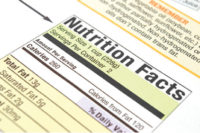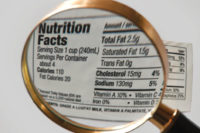New Look Labels: Added Sugars
FDA considers setting a daily value for added sugars

SOURCE: Copyright alexskopje
The Nutrition Facts panel will have a new look once the Food and Drug Administration (FDA) finalizes its 2014 proposed rule. One of the most significant changes that the new label is likely to feature is an “added sugars” line, declared as a quantitative amount and also expressed as a percent of the daily value.
The “daily value” component was included for the first time in FDA’s supplemental proposal issued this past summer. This feature of the supplemental proposal signals a tentative determination that “added sugars” will be part of a final rule, notwithstanding that some stakeholders had commented to FDA that requiring this information in the Nutrition Facts panel was unnecessary and likely confusing to consumers. We examine the issues in play and the practical challenges the food industry will face if “added sugars” and a daily value for “added sugars” are adopted by FDA.
FDA proposes to set a daily value of 50g added sugars for adults, or the equivalent of 10% of daily caloric intake. The proposal is based on the scientific evidence presented in the 2015 Dietary Guidelines Advisory Committee (DGAC) Report, which caused the agency to reverse its tentative conclusion in the initial proposed rule that there was “no sound scientific basis” to set a daily value for added sugars. The DGAC Report found “strong and consistent” evidence that dietary patterns associated with decreased risk of cardiovascular disease are characterized by lower consumption of sugar-sweetened foods and beverages (among other dietary patterns). FDA cited this evidence to support its supplemental proposal, along with comments stating that a daily value would help consumers to put the amount of added sugars in a food in the context of their daily diet.
FDA’s approach to establishing a proposed daily value for “added sugars” is novel. Most daily values are based on a recommendation from an Institute of Medicine (IOM) report, which is issued by a branch of the federal government and is generally accepted as reflecting scientific consensus. The proposed daily value for added sugars, in contrast, is based on the recommendations of a non-governmental advisory committee. The committee’s report does not necessarily reflect scientific consensus. This committee also reviewed research that is not of the same type that is typically relied upon to set a daily value. For example, the DGAC considered dietary pattern modeling, rather than dose-response research specific to added sugars.
The IOM last reviewed added sugars in 2002 and found that there was insufficient evidence to set an upper level for total or added sugars. (By way of comparison, FDA considered setting a daily value for trans fat in 2003, and it declined to do so because the most recent IOM report did not make quantitative intake recommendations for trans fat.) Although the IOM did not recommend a specific quantitative intake for added sugars, it did suggest that no more than 25% of daily calorie intake should come from added sugars, an amount significantly higher than the 10% of energy level underlying the daily value proposed by FDA.
Also of concern is the potential consumer confusion when there is a percent daily value declared on the label for “added sugars” but not total sugars. FDA found there was insufficient evidence to establish a daily value for total sugars. There is a broader concern that consumers will not understand the difference between added and total sugars.
This concern was underscored by the consumer research that FDA published as part of its supplemental proposal. The research examined the addition of an “added sugars” line to the nutrition label, and found that while the line helped study participants to determine the amount of added sugars in a product, it also resulted in fewer participants being able to correctly identify the amount of total sugars in the product. Some consumers were confused about the difference between added and total sugars or added the two values together to determine “total sugars.”
Additionally, FDA did not test the addition of a percent daily value for added sugars. Rather, the consumer research only included the amount of added sugars in grams. Overall, the consumer research found the proposed changes to the nutrition panel to have only equivocal results and did not provide strong evidence that the changes would help improve consumer understanding of nutrition information.
FDA accepted comments on the supplemental proposed rule until October 2015, and declined to issue an extension to the comment deadline. This suggests that the agency is working as quickly as possible to finalize the rule during the current presidential administration.
The addition of added sugars to the nutrition label, if finalized, would present a number of implementation challenges. While some of these issues may be addressed by FDA in a final rule, industry will still likely face new requirements and challenges.
There is no test method that can detect added sugars as distinct from naturally occurring sugars, so the amount of added sugars would need to be determined by an analysis of the product formulation. Additional records would need to be kept to substantiate the amount of added sugars declared. It is not clear what type of records would be necessary or sufficient.
Questions remain about what counts as added sugars and how to determine the amount of added sugars. For example, the industry received significant comments about whether the added sugars definition should include an added ingredient that contains naturally occurring sugars but that is not added for the purpose of increasing the sweetness of the food (such as fruit juice concentrate or lactose).
The addition of a new nutrient to the nutrition label is always a significant development, but the addition of added sugars, a type of ingredient rather than a nutrient, would present special challenges. Stay tuned to see how FDA addresses these issues in the final rule.
Looking for a reprint of this article?
From high-res PDFs to custom plaques, order your copy today!





